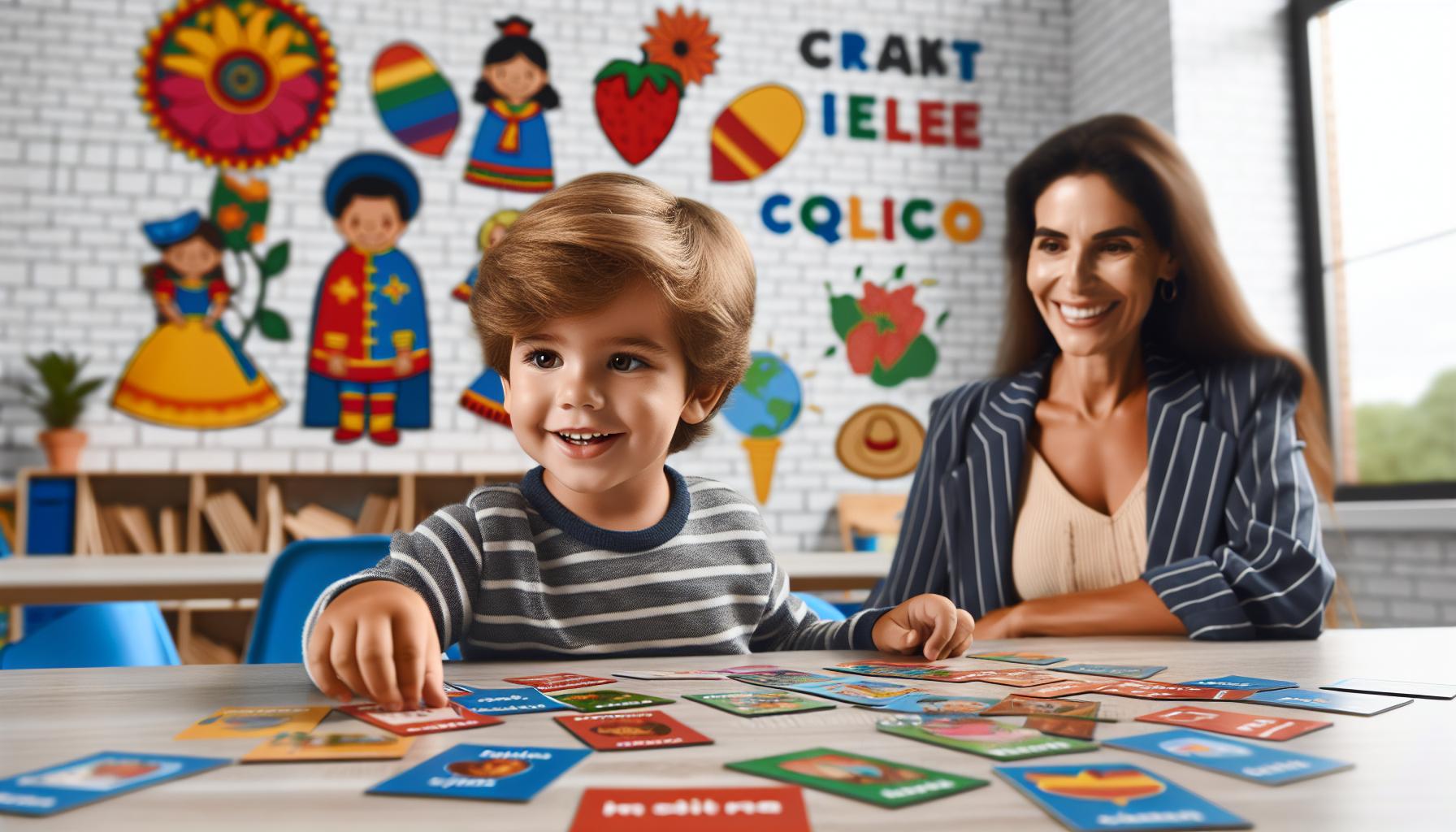
Key Takeaways
- Homeschooling Spanish requires a well-suited curriculum that matches your child’s learning style and developmental stage while offering gradual progression.
- Interactive tools like flashcards, games, and audio exercises enhance engagement and reinforce key language skills effectively.
- Quality Spanish curriculums incorporate cultural immersion through stories, traditions, and activities to deepen connections with the language.
- Setting a consistent routine, integrating interactive practices, and tracking progress are essential strategies for successful Spanish learning at home.
- Homeschooling offers flexibility and customization but requires careful planning, especially to address challenges like lack of immersion and motivational hurdles.
- Leveraging online resources and supplementary tools can complement lessons, providing both structure and adaptability for diverse teaching approaches.
Teaching Spanish at home can feel overwhelming, especially when we’re trying to find resources that truly fit our child’s learning style. We want a curriculum that’s engaging, effective, and helps build confidence in using a new language. But how do we choose the right one without second-guessing every option?
As parents, we understand the desire to create an enriching learning experience. Spanish is more than just vocabulary—it’s about understanding culture, communication, and connection. Whether we’re beginners or fluent speakers ourselves, a well-structured approach can make all the difference in how our children embrace the language.
What if we could simplify the process and focus on what really works? By exploring different methods and tools, we can find a Spanish curriculum that feels manageable and rewarding. Let’s dive into what makes a great homeschooling Spanish program and how we can set our kids up for success.
Importance Of Choosing The Right Homeschooling Spanish Curriculum
Picking the right Spanish curriculum shapes your child’s learning experience. A well-suited program offers clear guidance, practical activities, and engaging content. It also matches your teaching style, helping lessons flow more smoothly.
Every child has a distinct way of learning. Some are visual learners, while others understand concepts better through listening or hands-on activities. Does your chosen curriculum align with these preferences? Programs that cater to how your child absorbs information make lessons more impactful and enjoyable.
Grammar, vocabulary, and conversational skills play a major role in language acquisition. Does the curriculum you’re considering focus evenly on these areas? Effective Spanish programs integrate these components clearly and progressively.
Cultural understanding enhances language learning. Does the curriculum expose your child to Hispanic cultures, traditions, and histories through stories, music, or activities? Engaging with cultural context creates opportunities for a deeper connection to the language.
Flexibility also matters. Homeschool routines often vary. A curriculum offering structured yet adaptable resources allows lessons to fit naturally into daily schedules. Does it provide online, printed, or multimedia options you can easily manage?
Investing time in choosing the right curriculum builds a strong foundation for language fluency. Asking these questions helps identify programs that match your child’s needs and your teaching approach.
Key Features To Look For In A Spanish Curriculum

Choosing the right Spanish curriculum can feel overwhelming, but focusing on specific features simplifies the process. What makes a curriculum truly effective for your child? Let’s explore critical components that enhance their learning journey.
Age-Appropriate Content
Curriculum content must align with your child’s developmental stage. Younger learners often benefit from simple vocabulary, songs, and visuals, while older students may require structured lessons with grammar rules and cultural discussions. Does the curriculum match your child’s current abilities yet provide opportunities for growth? Look for materials that progress gradually without overwhelming learners, offering activities or lessons that challenge them appropriately.
Interactive Learning Tools
Engagement increases when the curriculum includes tools that make learning active. Flashcards, online games, audio exercises, and mobile apps provide variety and reinforce concepts. Are interactive elements included to keep your child motivated? Choose a curriculum that mixes traditional methods with hands-on activities, creating a more dynamic learning environment for different preferences.
Cultural Immersion Elements
Language and culture go hand in hand. A quality curriculum integrates cultural exposure through stories, songs, holidays, or traditions to foster a deeper connection with Spanish-speaking communities. Does it incorporate activities that highlight Spanish-speaking regions’ diversity? Including these elements brings the language to life and helps children grasp its real-world significance.
Top Homeschooling Spanish Curriculum Options

Finding the right Spanish program for homeschooling can feel overwhelming. To simplify the process, we’ve highlighted programs for different proficiency levels and included online resources to support your teaching journey.
Curriculum For Beginners
Beginner programs focus on foundational skills like basic vocabulary, pronunciation, and everyday phrases. These curriculums often use interactive tools such as songs, stories, and visual aids to capture attention and make learning enjoyable. For younger children, consider programs offering colorful visuals and simple word exercises to promote early language retention. Older beginners may benefit from structured lessons that incorporate practical activities like flashcards and conversational practice. Do you think your child prefers learning visually or through hands-on interaction? Understanding their preference can help narrow your options.
Intermediate And Advanced Level Programs
Intermediate and advanced curricula build on existing knowledge. They often emphasize grammar rules, verb conjugations, and expanding vocabulary to create more complex sentences. Advanced learners can expect lessons that focus on fluency through activities like writing essays, debates, or discussing abstract topics. Programs for these levels often integrate cultural materials such as literature or regional dialects, helping learners connect more deeply with Spanish-speaking communities. Do you notice your child craving more conversational challenges or cultural depth in their studies? These programs can meet those expectations while refining their language skills.
Online Resources And Platforms
Online tools broaden access to diverse approaches for homeschooling Spanish. Many platforms include interactive exercises, live tutoring, and quizzes that adapt to your child’s proficiency. Resources like downloadable audio tracks or apps support active listening and pronunciation practice on the go. Online platforms also frequently include cultural content, exposing students to Spanish traditions, geography, and customs. Whether you’re guiding a lesson or seeking supplemental material, these resources fit into different schedules and learning styles. Have you explored how adding digital tools could complement your teaching strategy? Online options can make language learning more engaging while offering flexibility.
Tips For Effectively Using A Spanish Curriculum At Home
Using a Spanish curriculum at home can feel overwhelming, but we can make the process more effective with clear strategies. Focusing on consistency, engagement, and progress measurement makes learning both manageable and enjoyable.
Setting A Routine
A consistent routine provides structure and helps children develop good study habits. Scheduling daily or weekly Spanish lessons helps integrate the language naturally into homeschooling. Short, frequent sessions often work better than long, infrequent ones, especially for younger learners.
What time of day does your child learn best? Mornings might work for focused grammar tasks, while afternoons could be better for creative activities like storytelling or games. Build flexibility into your schedule to accommodate changes without disrupting learning momentum.
Incorporating Practice And Activities
Interactive practice reinforces language lessons and builds confidence in real-world use. Activities like role-playing, storytelling, or creating flashcards make learning more dynamic. For example, practice saying grocery items in Spanish during errands or incorporate Spanish songs into your day to strengthen listening skills.
Pair lessons with hands-on activities to engage different learning styles. Visual learners benefit from charts and videos, while auditory learners excel with songs and pronunciation drills. How can you make language practice part of your daily interactions?
Tracking Progress
Regularly tracking progress highlights areas where improvement is needed and celebrates milestones. Create small, measurable goals like mastering ten new words a week or holding a brief conversation in Spanish. Keeping a progress journal or using digital tools to assess grammar, vocabulary, or pronunciation skills offers valuable insights.
How do you recognize your child’s growth? Praise their achievements, no matter how small, to motivate continued effort. Adapting activities based on progress ensures lessons stay challenging but not frustrating.
Pros And Cons Of Homeschooling Spanish Curriculum
Every educational choice has advantages and challenges. Homeschooling Spanish allows parents to shape the learning experience but also requires careful planning. Let’s explore the benefits and challenges involved.
Benefits Of Homeschooling Spanish
- Flexible Learning Schedule
Homeschooling lets us adapt lessons to fit our family’s daily routine. By doing so, we can dedicate time to focus on challenging areas or move faster through concepts our child masters quickly.
- Customized Teaching Approach
We have the ability to choose materials that suit our child’s learning style. Whether they prefer interactive apps, written exercises, or speaking practice, we can pick resources that help build confidence and engagement.
- Cultural Integration
Incorporating music, cuisine, and traditions from Spanish-speaking countries makes learning more meaningful. This exposure creates an appreciation for the culture alongside language skills.
- Individual Attention
With homeschooling, we can address specific strengths and weaknesses. This approach supports consistent progress and allows for immediate adjustments to teaching methods if something isn’t working.
- Cost Control
Homeschooling can be budget-friendly since we decide which resources to invest in. Many free or affordable tools, like online games or audio resources, are readily available.
- Time Investment
Planning and teaching a Spanish curriculum requires ongoing commitment. Parents juggling multiple responsibilities may find it challenging to maintain consistency without proper organization.
- Lack Of Language Immersion
Homeschool environments may not replicate the natural exposure of hearing and speaking Spanish daily. To counter this, we can integrate language apps, online videos, or conversational practice with native speakers.
- Limited Expertise
Not every parent feels comfortable teaching a second language. It can be intimidating if we’re not proficient, but using structured programs or tutors can bridge these gaps.
- Motivational Challenges
It can be hard to motivate children, especially if they find language learning repetitive or difficult. Incorporating games, music, or group activities might make lessons fun and encourage participation.
- Progress Measurement
Being solely responsible for tracking progress may feel overwhelming. Regular assessments or reviewing benchmarks can help us see improvement and fine-tune the curriculum where needed.
By understanding these pros and cons, we can better approach homeschooling Spanish and create an environment that supports meaningful learning experiences. How do you plan to create balance between flexibility and consistency in your lessons?
Conclusion
Homeschooling a Spanish curriculum offers a unique opportunity to tailor language learning to our children’s needs while fostering a deeper appreciation for Spanish culture. By selecting a program that aligns with their learning style and incorporating interactive and cultural elements, we can create an engaging and effective experience.
While there are challenges, the flexibility and personalized approach of homeschooling allow us to adapt and overcome them. With the right tools, consistency, and a focus on progress, we can help our children build confidence and fluency in Spanish, setting them up for long-term success.
Frequently Asked Questions
What is the first step in choosing a homeschool Spanish curriculum?
The first step is to assess your child’s learning style (visual, auditory, or kinesthetic) and your teaching approach. This helps identify a curriculum that aligns with both your child’s needs and your ability to teach effectively.
Why is cultural immersion important in teaching Spanish?
Cultural immersion helps children connect with the language by understanding its context. Stories, music, and traditions make learning more engaging while fostering a deeper appreciation for Spanish-speaking cultures.
What features should I look for in a Spanish curriculum?
Look for clear guidance, interactive tools, age-appropriate content, practical activities, and a balanced focus on vocabulary, grammar, conversation, and cultural elements.
How can I keep my child engaged while learning Spanish at home?
Incorporate interactive tools like flashcards, online games, songs, and storytelling. These activities make lessons fun and help maintain your child’s interest in learning.
What are the main challenges of homeschooling Spanish?
Challenges include limited language immersion, time-intensive planning, lack of expertise in teaching Spanish, and keeping children motivated throughout the learning process.
How do I measure my child’s progress in Spanish?
Track your child’s progress through regular assessments, such as vocabulary quizzes, conversational practice, and milestone celebrations. This helps identify areas for improvement and keeps learning rewarding.
Can I use online resources for teaching Spanish?
Yes, online resources like interactive exercises, live tutoring, and cultural content offer flexibility and tools to adapt lessons to your child’s proficiency level.
What are the benefits of homeschooling a Spanish curriculum?
Homeschooling offers flexibility, customized teaching approaches, individual attention, cultural integration, and cost control, allowing you to tailor the curriculum to your child’s needs.
How often should I incorporate Spanish lessons at home?
Consistency is key. Aim for short, daily lessons to build a routine, reinforce progress, and prevent overwhelming your child with too much information at once.
Is it necessary to have prior Spanish knowledge as a parent-teacher?
While prior Spanish knowledge helps, it’s not essential. Many curricula include detailed guides, audio resources, and online support to assist parents with limited Spanish proficiency.

